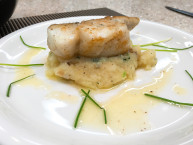Last semester I joined a light music circle at Kyoto University. This semester however, because of final exams for the Japanese university students and their semester ending in March, I decided to pivot and instead take once-a-week cooking lessons at La Carriere Cooking School on Sanjo-Kawaramachi. I found out about the school through a group cooking event organized by KCJS during my fall semester.
Interpret this as you may, but classes are split up according to gender. Further, lesson prices are higher for female students than male students. The women have a wider selection of lessons at their disposal, while the ones that share the same content as men often have an extra dish incorporated into them. As a student, I received a generous 25% discount for my lessons from January to April.
The lessons are divided up as follows: Washoku, Yoshoku, and beginner’s skills. Each month there is one Washoku class, one Yoshoku class, and two beginner’s classes. Since I cook frequently back in America, I went into the first month feeling confident about the beginner’s courses, but decidedly more nervous about the more specialized classes.
For the first lesson or two, I would arrive an hour early and painstakingly translate the entire recipe sheets for the session’s two dishes. We were then directed to our demo room, consisting of 8 workstations made for two people apiece. At the start of the lesson, the head chef and his assistant would demo the entire cooking process for the night, referring to the sheets as needed and adding personal tips along the way. We would then be let loose, and working with our assigned partner (who changed every week), we would go through the sheets together and cook, assisting each other as needed.
What I quickly discovered was that I only needed to know the names and Kanji for ingredients unfamiliar to me, while the actually procedure I could pick up by ear pretty easily from the chef. If I ever got hung up on something, all I would need to do is wave down either the head chef or the assistant chef, or simply ask my partner. Yoshoku lessons became my favorites, because they used a lot of ingredients and techniques that I was already quite familiar with back home. In addition, I developed a fast friendship with the chef that always headed those lessons, a Japanese man who cooked in France for a few years of his life. Of all the teachers I had this semester, he was the one who engaged with me the most.
I kept all of the recipe sheets that I was given, and intend to use some of them again in the future when I’m cooking for myself. Over the course of the semester, I’ve learned a great deal more of Japanese vocabulary, gotten to know some new techniques, and interacted with people from a variety of backgrounds but united by a passion for cooking.


Having considered this as a CIP myself, it was incredibly interesting reading about your experience with the cooking classes. You descriptions give a very clear impression, not only of the amount of dedication you put into this activity, but also into the general interactions surrounding it. One thing that stuck me, as I am sure you were expecting, was the fact that the classes are separated by gender, and have minor discrepancies. I am curious as to whether you had any opportunity to get a sense of the women’s classes, or why they were separated in this way. On a more individual note, do you have any favorites among the dishes you learned this semester?
Lauren took the women’s class, and we occasionally compared notes. She said at one point that a class was just her, another student and the teacher. With me, there’s about 7 or 8 regulars who I see every week, and then about once a month someone coming in for a trial class to see if they want to sign up for more classes or not. The school also offered weekend courses outside of regular classtime that didn’t divide by gender, but I never went because it cost extra (4000-6000円) outside of my plan.
One of the more simple foods I picked up from my classes, that I’ve always wanted to pick up, is dashimaki. The first time I saw someone making it, it was in the basement of Mitsukoshi up in Tokyo with my mother. We watched for maybe 10 minutes, observing the chef handle four pans at once with ease. My mother then turned to me and said, “Okay, I think I can do that.” Lo and behold, I get a text later that week with a picture of her perfect dashimaki. Ever since then, I’ve wanted to be able to make it. In class it came out perfectly well, but when I tried to do it again at Dr. Chance’s apartment during our sushi-making field trip, it came out more like a dashi-blob than dashimaki.
More practice is necessary.
Sounds like a great experience! What stands out to me the most is how much different the cooking class you attended seems compared to the one I participated in once a month. Yours definitely seems a lot more structured and in-depth, while mine was much more casual.
Though in any case, do you plan on taking any more cooking classes once you get back to the US (regardless of whether these classes might be focused on Japanese food or some other sort of cuisine)?